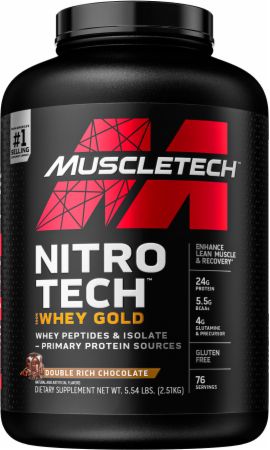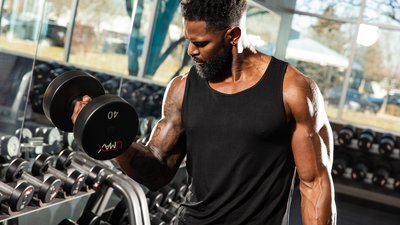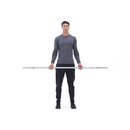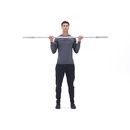When it comes to arms, the bigger the better, right? Go ahead and enter "world's biggest arms" in a search engine, and you'll soon find out that isn't even remotely the case. That is, unless your idea of awesome is hanging two ugly, misshapen, overstuffed gunny sacks of lumpy flesh from your shoulders.
As with just about everything in the realm of bodybuilding, a few misguided folks have taken arm development way too far. Unlike, say, Arnold Schwarzenegger's bombers (which clocked in at 22 inches and flowed seamlessly with his muscular 6-foot-2-inch frame), we've seen guys over the years use unnatural means to cross the 25- and even 30-inch mark, which looks more like a cry for help than a training goal.
Aim for Strategic Muscle Growth
Instead of pursuing arm girth at all costs, MuscleTech-sponsored athlete Fabian Petrina suggests a more targeted approach.
"My whole goal with training is to create something aesthetically pleasing to look at," he explains. "I'm a bodybuilder, and achieving a perfect biceps peak is my goal. I want arms that look impressive but can still fit in a suit. Twenty-five-inch arms don't look good on anyone."
To help achieve that goal, Petrina has developed a twice-per-week biceps attack, once with back and once with shoulders and triceps, that focuses on quality over mass. Yes, you'll build some muscle on this program—but you'll do it strategically, with emphasis on carving out an impressive, proportional peak.
For every new exercise, do 1-2 warm-up sets, but don't overdo the reps.
"Those warm-ups sets should be 3-4 reps with about 50 percent of your working weight—just enough to jumpstart your mind-body connection and make sure there are no aches, pains, or twinges anywhere," Petrina says.

BodyFit
$6.99/month- 2,500+ expert-created single workouts
- 3,500+ how-to exercise videos
- Detailed workout instruction
- Step-by-step workout tips
- Training at gym or at home
- Access to Workout Plans
- Access to Bodyfit App
- Store Discounts
Already have a Bodybuilding.com account with BodyFit? Sign In

What comes with BodyFit?

- Instructional Videos
Don't risk doing a workout improperly! Avoid injury and keep your form in check with in-depth instructional videos.

- How-to Images
View our enormous library of workout photos and see exactly how each exercise should be done before you give it a shot.

- Step-by-Step Instructions
Quickly read through our step-by-step directions to ensure you're doing each workout correctly the first time, every time.
"Like calves, biceps are a slow-twitch, red-muscle-fiber-dominant body part," Petrina explains. "They recover more quickly, which is why I recommend training biceps twice per week, once with back and once with shoulders and triceps."
These sessions don't have to be excruciatingly long. "On back day, your biceps training will be short and sweet, just 2 sets of 60-100 reps each," he says. "You've put heavy loads on your biceps already with rows and other pulling movements, so these high-rep burnouts hit them in a different way and help you really finish them off."
Technique Tips
Barbell Curl
Choose a weight that's about 30 percent below your 10-rep max. If you can do 10 reps with 100 pounds, 30 percent below is 70 pounds.
"Aim for doing 20-25 reps with that weight, then cut the weight in half and do as many as you can," Petrina says. "If you fail before you hit at least 60 reps, cut the weight in half again so you can at least get your 60 before hitting the wall."
For both sets, use a grip that's a little wider than usual—about one hand outside shoulder width.
"This will help hit that inner head of your biceps," says Petrina. "Also, shift the weight onto your outer palms, by your pinkie, and really own the weight by going slowly. Take about 2 seconds up and 3-4 seconds down, and really squeeze the biceps at the top. Over the course of each set, you'll build an insane pump, and should really feel your biceps tightening up."
Cable Hammer Curl (Rope Attachment)
"With the neutral grip, you'll hit the brachialis, the muscle that runs beneath the biceps, to give your peaks some lift," says Petrina. "You should also twist your hands into a supinated position as you come up to the top of the curl, which directly engages each peak."
The 2 sets shouldn't take more than 5 minutes, during which you'll force blood into the area until you reach muscle failure. Two or three days later, when your biceps have had a chance to recover, hit them again with a more traditional workout.


BodyFit
$6.99/month- 2,500+ expert-created single workouts
- 3,500+ how-to exercise videos
- Detailed workout instruction
- Step-by-step workout tips
- Training at gym or at home
- Access to Workout Plans
- Access to Bodyfit App
- Store Discounts
Already have a Bodybuilding.com account with BodyFit? Sign In

What comes with BodyFit?

- Instructional Videos
Don't risk doing a workout improperly! Avoid injury and keep your form in check with in-depth instructional videos.

- How-to Images
View our enormous library of workout photos and see exactly how each exercise should be done before you give it a shot.

- Step-by-Step Instructions
Quickly read through our step-by-step directions to ensure you're doing each workout correctly the first time, every time.
Technique Tips
Barbell Curl and Triceps Push-down
Use a standard shoulder-width grip for this superset. For your 2-3 working sets, don't pyramid up. Rather, go right to your 10-rep-max weight after 1-2 warm-ups.
"If your working weight is 100 pounds, do 2 sets of 50 pounds, 3-4 reps apiece, to warm up," says Petrina. "I don't believe in pyramiding. Why would you want to exhaust yourself on a weight that's not even your max?"
Cadence is critical here. For curls, Petrina suggests a 2-second positive, followed by a 3-4 second negative. Repeat this pattern with the push-downs. Don't rest at all within the superset, but take a 60-90 second break between supersets.
Machine Preacher Curl and Seated Overhead Press
"The main thing to focus on with the preacher curls is getting the most out of the negative," Petrina says. "Your shoulders should be relatively relaxed because of the support, so you can bring the weight down slowly and then explode up. Use a 1-second positive, then a 4-5-second negative."
Concentration Curl and Reverse-Grip Triceps Push-down
Petrina says that when you do concentration curls, less weight is more.
"Don't focus on the weight, but on the control and squeeze," he says. "In many cases, I can achieve a better burn and better results with a 20-pound dumbbell than I can with a 50. The most important thing you can do for yourself on arm day is leave your ego outside and go light enough to control the weight."
You can also wring more out of concentration curls by using a wrist twist. Start with your hand in a neutral-grip position, with your palm facing the opposite leg. As you curl the dumbbell, supinate your wrist so your grip is underhand at the top. In fact, you want to turn your wrist a bit farther than that for maximum effect.
"Think of it as wanting to touch your nose with your pinkie," Petrina suggests. "Obviously, the dumbbell is in the way and you can't physically do that, but that's how much you want to rotate your wrist as you reach the top."
On the last superset, do 3 sets of 10-15 reps apiece. Choose weights that cause you to reach failure in that rep range. Finish with one burnout set, dropping the weight 30-50 percent, depending on how exhausted you are. Push through 20-25 more reps.
Your Path to the Peak
This workout regimen should work well for most people, especially beginners with a few months of experience and intermediates who have reached a plateau in their biceps development. But there's no one-size-fits-all approach.
"Try this routine for 4-6 weeks or longer to see how your body reacts to it," Petrina says. "Some people might find they respond better with really heavy weights and low reps instead of this approach, and that's fine. It all depends on your muscle composition, whether you're more red-fiber (slow-twitch) or white-fiber (fast-twitch) dominant. That's why experimenting with different approaches is key."




